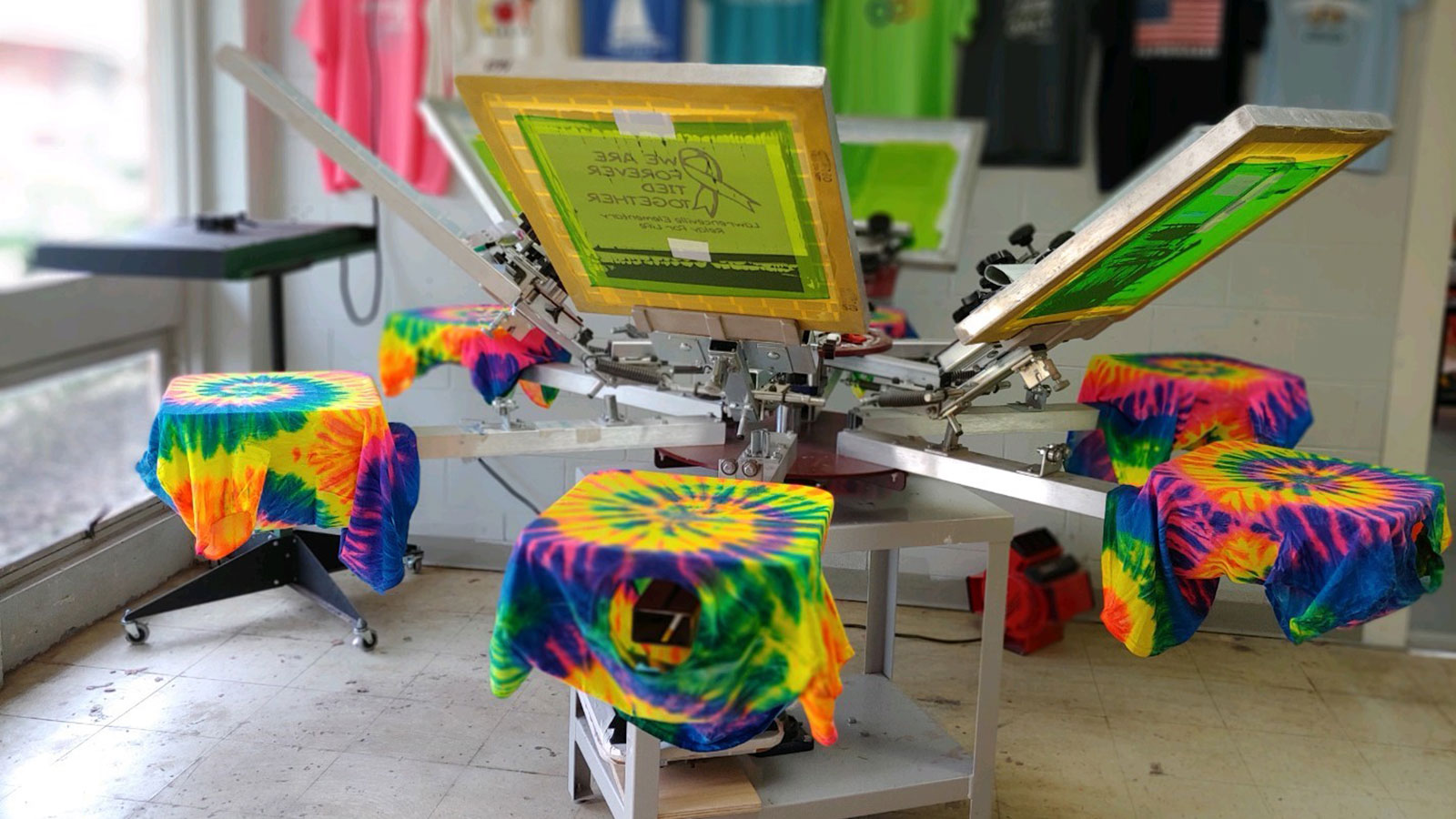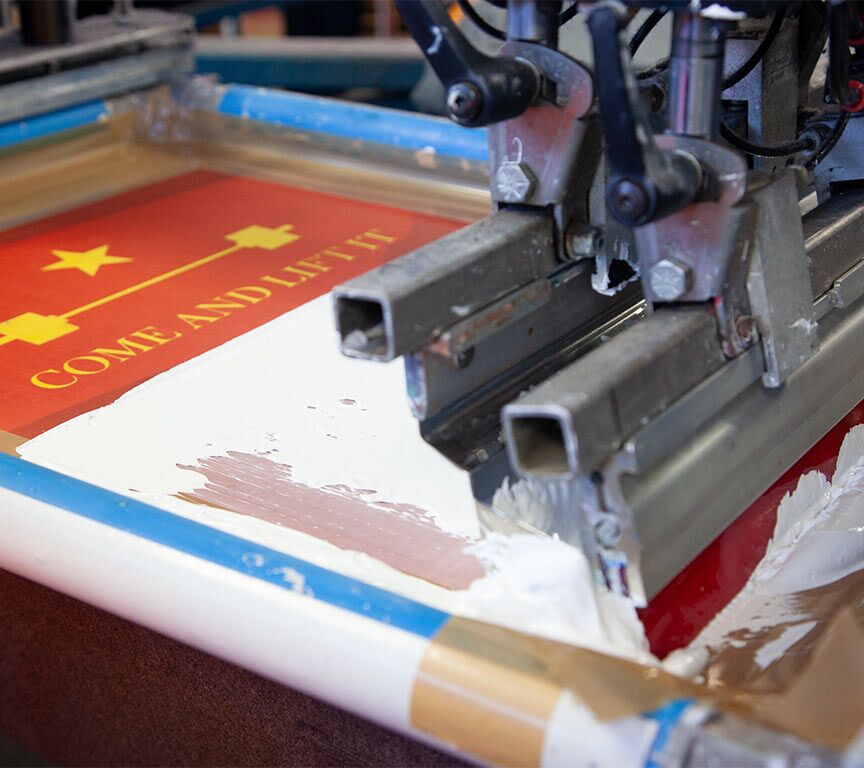Vintage Style Silk Screen Printing for Retro Fashion
Vintage Style Silk Screen Printing for Retro Fashion
Blog Article
Screen Printing Uncovered: Every Little Thing You Need to Find Out About T-Shirt and Garment Printing Strategies
If you've ever asked yourself exactly how those dynamic styles end up on your favored tees, you remain in the right area. Screen printing is a fascinating approach that integrates art with method, supplying unlimited opportunities for creative thinking. Comprehending the fundamentals, from equipment to ink choices, can greatly influence your results. Prepared to discover the crucial components that make screen printing an art form? Allow's discover the details that can boost your tasks.
The Essentials of Display Printing: How It Functions
When you dive into display printing, you'll find it's both an art and a science. At its core, screen printing entails developing a stencil, or display, that enables ink to pass via only in certain locations (screen printing kit). You begin by selecting your style and preparing your display with a light-sensitive solution. As soon as you expose this solution to light, it solidifies, leaving your design as a negative room.
Following, you'll blend your inks and prepare your printing surface. Setting the screen over the material, then make use of a squeegee to push ink with the screen onto the garment. This procedure needs accuracy, as you desire clear, lively prints. After printing, you'll cure the ink with heat, ensuring it sticks to the fabric and lasts via washes. Each step is crucial, and understanding them will raise your display printing abilities, transforming easy garments right into special, meaningful pieces.
Sorts Of Display Printing Techniques
As soon as you realize the basics of display printing, it's time to check out the various methods that can elevate your designs. One preferred technique is standard display printing, where ink is pressed with a stenciled screen. This method is great for strong, dynamic shades. After that there's water-based ink printing, which supplies a softer feel and is environment-friendly, however it requires a different technique to healing.
If you're intending for great information, think about discharge printing. This method eliminates color from the fabric, leaving a soft, vintage appearance. One more option is plastisol printing, known for its toughness and brilliant colors, making it a preferred for numerous brands. Finally, explore halftone printing to produce gradient effects and elaborate designs. Each method has its unique appeal, so do not hesitate to try them bent on discover what fits your style best!
Essential Equipment for Display Printing
To achieve spectacular results in screen printing, having the right tools is essential. You'll require a tough display printing framework, which holds the mesh that transfers your style onto the garment. Next, invest in top notch mops; these are important for using ink uniformly across the display.
Choosing the Right Inks and Materials
When choosing inks and materials for screen printing, you need to take into consideration the sort of ink that functions finest for your project. Think of fabric compatibility to ensure your designs look last and fantastic long. Additionally, check out environment-friendly ink choices to make your printing procedure a lot more sustainable.
Types of Display Inks
Choosing the right screen ink is crucial for attaining dynamic, resilient prints that fulfill your project's demands. There are several kinds of screen inks to examine. Plastisol ink is popular for its flexibility and convenience of usage, offering outstanding color opacity on dark fabrics. Water-based ink, on the other hand, offers a softer feeling and is eco-friendly, making it perfect for those seeking to minimize their ecological influence. Discharge inks remove dye from the textile, causing a soft, classic look but call for details handling. Finally, specialized inks, such as metal or glow-in-the-dark, can add one-of-a-kind impacts to your styles. Review your job requirements and pick the ink that straightens ideal with your wanted end result.

Fabric Compatibility Factors To Consider
Understanding material compatibility is important for achieving high-grade screen prints, especially since different materials respond uniquely to numerous inks. Constantly evaluate your inks on sample fabric to ensure they stick appropriately and preserve color stability. Additionally, maintain in mind that material weight and texture can influence the last end result, so picking the right ink and material combo is vital for your job's success.
Eco-Friendly Ink Options
Green inks are becoming a preferred option for display printers who wish to reduce their ecological influence while maintaining quality. When picking inks, think about water-based inks, which are less hazardous and much easier to tidy up contrasted to standard solvents. These inks bond well with fabrics, delivering vibrant results without hazardous chemicals. You could likewise explore eco-solvent inks that utilize fewer unstable organic compounds (VOCs), making them a safer choice for both your health and the earth.
In redirected here addition, search for inks made from renewable energies, such as soy or vegetable-based options. By selecting the ideal inks and materials, you'll not just develop sensational styles but also add to a much more sustainable printing process. Make the button, and your prints will certainly mirror your dedication to the setting!
Preparing Your Design for Display Printing

File Format Needs
To assure your layout looks sharp and vibrant on material, you'll require to pay close attention to submit style demands for screen printing. Make sure your style has a transparent background to protect against undesirable white sides on your prints. Maintain color settings in mind; CMYK is typical for display printing, so transform your RGB makes accordingly.
Shade Separation Techniques
Color splitting up is a crucial action in preparing your layout for screen printing, and understanding it can greatly improve your print quality. You'll need to break your design into specific shades, as each shade requires a different screen during printing. Begin by determining all the colors in your design and produce layers for each one. You can utilize software like Adobe Photoshop or Illustrator to separate and separate colors successfully. Be certain to save each layer as a separate file, generally in a style like TIFF or PSD. This precision not only ensures precise shade depiction but also simplifies the printing process. By focusing on color separation, you'll achieve professional and go to website dynamic lead to your screen-printed garments.
Resolution and Dimension
Achieving the very best cause display printing starts with guaranteeing your layout has the right resolution and dimension. Preferably, your artwork needs to be at the very least 300 DPI (dots per inch) for sharp, clear prints. Your final item may look less than professional and pixelated. if you use lower resolution.
When it comes to size, consider the measurements of your print area. Layout your artwork to match the final print dimension, ideally producing it in the real measurements you'll be printing. By doing this, you'll stay clear of any kind of unexpected scaling concerns.
Always check your design in both vector and raster styles. Vector graphics can be scaled without losing quality, making them optimal for screen printing. Preparing appropriately will assure your style looks amazing on every garment!
Step-by-Step Screen Printing Process
Screen printing is a vibrant process that enables you to develop vivid designs on numerous surfaces. To get going, you'll require a display, solution, and your chosen ink. Prepare your display by cleaning it completely. Next off, use the solution equally and let it dry in a dark location. When completely dry, reveal your display to light with your layout positioned on it, which will certainly solidify the emulsion where the light hits, developing a pattern - screen printing kit.
Pour ink onto the screen and make use of a squeegee to push the ink through the pattern onto the textile. Raise the screen meticulously and let the print completely dry. You have actually effectively display printed your style.
Tips for Successful Screen Printing Projects
While you're diving right into your screen printing projects, bear in mind that prep work is key to success. Beginning by collecting all your products-- inks, garments, squeegees, and displays. A clean work area assists stop undesirable mistakes, so clean prior to you begin.
Next, verify your art work is high-resolution and effectively sized for your garment. Evaluate your screen for correct direct exposure and Bonuses clean it thoroughly to stay clear of spots. When mixing your inks, adhere to the producer's guidelines to attain the right uniformity.
Throughout printing, apply even pressure with your squeegee for regular outcomes. Don't hurry; take your time to verify each print satisfies your standards. After printing, allow your garments completely dry entirely before dealing with or packaging them.
Last but not least, constantly maintain an example of your work for future referral. This means, you can analyze your progression and boost your strategies over time. Delighted printing!

Frequently Asked Inquiries
How much time Does It Require To Establish a Display Printing Work?
Establishing a display printing job normally takes around half an hour to an hour. You'll prepare the screens, mix inks, and adjust the press. The moment varies based on complexity and experience, so stay arranged!
Can I Print on Various Textile Keys In Using the Very Same Strategy?
Yes, you can print on various fabric kinds using the same strategy, however you'll need to adjust your setups and inks. Some textiles take in ink in a different way, so exploring guarantees the very best results for each product.
What Are Typical Blunders to Avoid in Display Printing?
When screen printing, stay clear of usual mistakes like using the incorrect ink, overlooking correct exposure times, or avoiding pre-press checks. Always evaluate your configuration and preserve clean screens to guarantee high quality results each time.
Exactly How Can I Appropriately Clean and Maintain My Display Printing Devices?
To effectively clean and keep your display printing tools, you must routinely clean screens with suitable solvents, check squeegees for wear, and ensure all tools are saved dust-free and completely dry. Uniformity enhances and avoids expensive repair services performance.
Is Display Printing Eco Pleasant Compared to Various Other Approaches?
Screen printing can be much more eco-friendly than other techniques, especially if you utilize eco-conscious products and water-based inks. By picking sustainable materials and techniques, you minimize waste and decrease your influence on the world.
Display Printing Uncovered: Whatever You Need to Know Regarding Tee and Garment Printing Methods
At its core, display printing includes producing a stencil, or screen, that allows ink to pass with only in specific locations. Placement the display over the fabric, then use a squeegee to push ink through the display onto the garment. One prominent method is standard display printing, where ink is pushed through a stenciled display.When choosing inks and products for display printing, you need to take into account the kind of ink that works best for your task.
Report this page